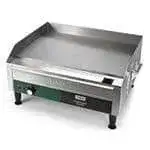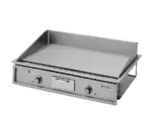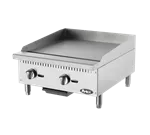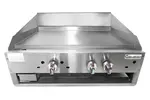
What is a Griddle? Types and Factors to Consider When Choosing the Perfect One
In the world of culinary delights, having the right cooking equipment can make all the difference. Among the many versatile appliances in the kitchens of chefs and home cooks alike, the griddle stands out as a true essential. With its flat and smooth surface, a griddle offers a wide range of cooking possibilities, making it a favored tool for preparing a diverse array of delectable dishes.
In this comprehensive guide, we will delve into the world of griddles, exploring their unique features, the various types available, and the essential factors to consider when selecting the perfect griddle for your specific cooking needs. Join us as we embark on a culinary journey and uncover the wonders of the griddle.
What is a Griddle?

A griddle is a cooking device with a flat and smooth surface, specially designed to prepare a variety of mouthwatering foods. Unlike traditional grills with raised ridges, a griddle's even heat distribution ensures consistent cooking and excellent results. Griddles come in different shapes and sizes, from portable countertop models to large floor models used in commercial kitchens.
Their versatility and efficiency have made them a popular choice for both professional chefs and home cooks. Whether you're whipping up a hearty breakfast for your family or creating culinary masterpieces in a bustling restaurant kitchen, a griddle is an invaluable companion that will elevate your cooking experience.
What Can You Cook on a Griddle?

The versatility of a griddle makes it suitable for cooking an impressive array of dishes. Here are some delicious options you can prepare on a griddle:
- Pancakes and Eggs: Say goodbye to unevenly cooked pancakes and eggs. The griddle's flat surface ensures that they turn out fluffy and perfectly cooked, delighting your breakfast table.
- Burgers and Sandwiches: Craving a juicy burger or a gooey cheese melt? The griddle's even heat distribution will give you the perfect sear and melt-in-your-mouth experience.
- Vegetables: Griddling vegetables enhances their natural flavors and textures, giving you deliciously charred asparagus, zucchini, and more.
- Seafood: Whether it's succulent shrimp, perfectly seared scallops, or tender fish fillets, a griddle is your ally in preparing delectable seafood dishes.
- Fajitas: The sizzling sound of fajitas on a griddle is a treat for the senses. Cook tender strips of meat and caramelized vegetables for a mouthwatering Tex-Mex feast.
- Stir-Fries: The spacious cooking surface of a griddle allows ample space for stirring and tossing vegetables and meats, ensuring an enticing stir-fry.
- Quesadillas: Crispy and cheesy quesadillas are easily achieved on a griddle, making it a go-to appliance for Tex-Mex enthusiasts.
- Breakfast Hash: Prepare a hearty breakfast hash with potatoes, onions, and your favorite breakfast meats, all on one griddle.
- Grilled Cheese: Indulge in a classic grilled cheese sandwich, quickly and easily made on a griddle for that perfect crunch and ooey-gooey center.
- Teppanyaki-style Dishes: If you opt for a teppanyaki griddle, you can bring the exciting flavors of Japanese teppanyaki cooking to your home kitchen. Prepare hibachi chicken, fried rice, and more regional delicacies with flair.
The Main Considerations When Choosing a Griddle

When it comes to equipping your kitchen with the right cooking appliances, choosing the perfect griddle is of utmost importance. A griddle is not just another kitchen tool; it's a culinary workhorse that can significantly impact the outcome of your dishes. Whether you're a professional chef running a bustling restaurant or a home cook looking to elevate your dishes, selecting the right griddle tailored to your specific needs is essential for achieving outstanding cooking results.
The Importance of Choosing the Right Griddle for Your Needs
Let's explore the importance of choosing the right griddle and the main considerations to keep in mind during the selection process.
- Enhanced Cooking Performance: The right griddle can greatly enhance your cooking performance, allowing you to achieve culinary excellence in every dish you prepare. Whether you're searing meats to perfection, flipping fluffy pancakes, or delicately grilling seafood, a suitable griddle ensures even heat distribution and precise temperature control. This level of control enables you to execute a wide range of cooking techniques and ensures that your dishes are consistently cooked to perfection.
- Versatility and Adaptability: Griddles are versatile kitchen companions, capable of handling a diverse range of dishes. From breakfast classics like eggs and bacon to lunch favorites like burgers and sandwiches, and even elegant teppanyaki-style cooking, a well-chosen griddle opens up a world of possibilities. By selecting a griddle that aligns with your preferred cooking styles and menu offerings, you can effortlessly adapt to different culinary challenges and cater to a wide array of tastes.
- Optimal Space Utilization: For commercial kitchens and establishments with limited space, choosing the right griddle ensures optimal utilization of available kitchen real estate. Countertop griddles are perfect for smaller kitchens, while floor model griddles are designed for high-volume cooking in larger establishments. On the other hand, drop-in griddles offer a seamless and space-saving option for custom kitchen designs. Selecting the appropriate griddle type allows you to maximize your kitchen's efficiency and workflow.
- Improved Energy Efficiency: Energy efficiency is a critical factor for both residential and commercial kitchens. By choosing a griddle that aligns with your energy preferences, such as gas, electric, or induction, you can optimize energy consumption and reduce operational costs. Energy-efficient griddles not only benefit the environment but also contribute to overall cost savings in the long run.
- Durability and Longevity: Investing in a high-quality griddle means investing in its durability and longevity. Stainless steel griddles are known for their robustness and resistance to corrosion, making them ideal for heavy-duty use in commercial kitchens. Cast iron griddles, on the other hand, are renowned for their exceptional heat retention properties and ability to withstand rigorous cooking demands. By selecting the right griddle material, you ensure that your cooking appliance serves you well for years to come.
- Ease of Maintenance and Cleaning: Easy maintenance and cleaning are crucial factors for any kitchen equipment. Non-stick chrome griddles and stainless steel griddles are easier to clean and require less effort to maintain. Opting for a griddle with features that simplify the cleaning process saves time and effort, allowing you to focus on what matters most - creating delicious dishes.
Types of Griddles

Griddles come in various types, each designed to suit specific needs and spaces. Let's explore the common types:
- Countertop Griddles: These compact griddles are designed to sit on a countertop, making them suitable for smaller kitchens or establishments with limited space. They are perfect for homes and smaller restaurants where portability and space efficiency are essential.
- Floor Model Griddles: For high-volume cooking in commercial settings like restaurants or large catering events, floor model griddles are the way to go. These robust and large griddles can handle a significant volume of food, making them ideal for busy kitchens.
- Drop-in Griddles: Built into a counter or kitchen island, drop-in griddles offer a seamless and space-saving cooking surface, perfect for custom kitchen designs. They are a popular choice for upscale restaurants and luxury kitchen spaces.
- Teppanyaki Griddles: Teppanyaki griddles, also known as teppan grills, are a must-have for fans of Japanese cuisine. Their flat cooking surface allows for precise teppanyaki-style cooking, where meats, seafood, and vegetables are skillfully prepared right in front of diners for an interactive dining experience. Teppanyaki griddles are commonly found in Japanese restaurants and culinary entertainment venues.
Types of Griddles Based on Utility
Griddles are also classified according to the type of energy they use to generate heat. The main utility types are:
- Gas Griddles: Gas griddles are favored in commercial kitchens for their fast heating capabilities and precise temperature control. The convenience of gas allows for quick adjustments to the cooking temperature, ensuring consistent results. Gas griddles are commonly used in restaurants, diners, and food trucks.
- Electric Griddles: Electric griddles are versatile and easy to use, making them suitable for both residential and commercial applications. They offer even heat distribution, allowing for uniform cooking across the surface. Electric griddles are popular in households and smaller food establishments due to their ease of use and installation.
- Induction Griddles: Induction griddles use electromagnetic technology to generate heat directly on the cooking surface. They heat up quickly and provide precise temperature control, making them energy-efficient and responsive to adjustments. Induction griddles are known for their fast and precise cooking capabilities, making them ideal for high-end restaurants and professional kitchens.
Griddle Materials
The material of the griddle surface can significantly impact its performance and durability. The main materials used for griddles are:
- Stainless Steel Griddles: Stainless steel griddles are popular in commercial kitchens due to their durability, resistance to corrosion, and ease of cleaning. They are ideal for heavy-duty use and are well-suited for grilling a variety of foods. Stainless steel griddles are a staple in restaurant kitchens, foodservice establishments, and catering businesses.
- Cast Iron Griddles: Cast iron griddles have excellent heat retention properties, making them ideal for achieving a good sear on meats and maintaining a steady temperature throughout cooking. Cast iron griddles are revered by professional chefs and home cooks for their ability to create flavorful and perfectly cooked dishes.
- Chrome Griddles: Chrome griddles provide a smooth and non-stick surface, making them perfect for delicate foods like eggs and fish, where sticking can be an issue. They are easy to clean and maintain, making them a preferred choice in breakfast-oriented establishments and kitchens that prioritize ease of use.
Griddle Sizes
When choosing a griddle, size matters. Consider the following aspects:
- Hood Size: The hood size should be sufficient to cover the entire cooking surface, trapping heat and ensuring even cooking. Adequate hood coverage prevents heat loss, making the cooking process more efficient.
- Cooking Zone: The size of the cooking zone should match the volume of food you need to prepare regularly. For larger quantities or high-volume cooking, a spacious cooking zone is essential. However, for smaller kitchens and homes, a more compact cooking zone may suffice.
Temperature Control Styles
Temperature control is vital for achieving precise cooking results. Griddles typically come with two main temperature control styles:
- Thermostatic Control: Griddles equipped with thermostatic control allow you to set and maintain specific cooking temperatures. This feature is particularly valuable for precision cooking, where maintaining a constant temperature is critical. Chefs in fine-dining restaurants and culinary enthusiasts appreciate the accuracy and control provided by thermostatic griddles.
- Manual Control: Griddles with manual control provide a range of heat settings for you to adjust as needed. While not as precise as thermostatic control, manual control allows for more flexibility and experimentation in cooking. Manual control griddles are often found in casual dining establishments and homes, where cooks enjoy the freedom to adjust temperatures based on personal preferences.
Conclusion

A griddle is a versatile and indispensable cooking appliance that can elevate your culinary skills to new heights. From preparing a delicious breakfast to crafting mouthwatering lunch and dinner favorites, a griddle offers endless possibilities. The type of griddle you choose, whether it is a countertop griddle, floor model griddle, drop-in griddle, or teppanyaki griddle, will depend on your cooking needs and kitchen setup.
Considering factors such as the utility type (gas, electric, or induction), the material (stainless steel, cast iron, or chrome), and the size of the griddle will ensure that you make the right choice for your culinary endeavors. With the perfect griddle at your disposal, you can create kitchen masterpieces that will impress your guests, whether they are family, friends, or patrons of your restaurant.
Embrace the endless possibilities that a griddle offers and embark on a culinary adventure that will delight and satisfy the most discerning of palates. Remember, whether you're a professional chef or a home cook, the right griddle can make all the difference in transforming your dishes from ordinary to extraordinary.
FAQ
Which griddle material is best?
The choice of griddle material depends on your cooking preferences and needs. Each material has its advantages and disadvantages:
- Stainless Steel Griddles: Stainless steel griddles are a popular choice in commercial kitchens due to their durability, resistance to corrosion, and ease of cleaning. They can withstand heavy-duty use and are well-suited for grilling a variety of foods. However, they may not offer the same level of heat retention as cast iron.
- Cast Iron Griddles: Cast iron griddles are renowned for their excellent heat retention properties, making them ideal for achieving a good sear on meats and maintaining a steady temperature throughout cooking. They are favored by professional chefs and home cooks for their ability to create flavorful and perfectly cooked dishes. However, they require regular seasoning and proper care to prevent rusting.
- Chrome Griddles: Chrome griddles provide a smooth and non-stick cooking surface, making them perfect for delicate foods like eggs and fish. They are easy to clean and maintain, but they may not offer the same level of heat retention as cast iron.
What makes a griddle different from a grill?
The primary difference between a griddle and a grill lies in their cooking surfaces. Griddles have flat and smooth surfaces, while grills have raised ridges or grates. Griddles are better suited for cooking foods that require even heat distribution, such as pancakes, eggs, and vegetables. On the other hand, grills excel at creating grill marks and imparting smoky flavors to meats and vegetables.
What are griddles used for?
Griddles are incredibly versatile and can be used to prepare a wide variety of dishes. From breakfast classics like pancakes and eggs to lunch and dinner favorites like burgers, vegetables, and seafood, a griddle can handle it all. It is also ideal for teppanyaki-style cooking, where meats, seafood, and vegetables are skillfully prepared right in front of diners for an interactive dining experience.
How many types of griddles are there?
Griddles come in several types, each catering to specific needs and preferences. Some common types of griddles include countertop griddles, floor model griddles, drop-in griddles, and teppanyaki griddles. Additionally, griddles can be classified based on their utility types, such as gas griddles, electric griddles, and induction griddles.
What is the difference between a grill and a griddle?
The main difference between a grill and a griddle lies in their cooking surfaces. Grills have raised ridges or grates, creating grill marks on food and allowing fats and juices to drip away. They are excellent for grilling meats and vegetables with a smoky flavor. On the other hand, griddles have flat and smooth surfaces, ensuring even heat distribution and making them perfect for cooking foods that require a consistent cooking temperature, such as pancakes, eggs, and vegetables.
What are the advantages and disadvantages of using a griddle?
Griddles offer several advantages, including even cooking, versatile cooking capabilities, and easy cleanup, especially with non-stick griddle surfaces. They are excellent for cooking a wide range of foods and are ideal for preparing multiple items simultaneously. However, a potential disadvantage of using a griddle is the lack of grill marks on foods, which some people prefer for aesthetic and flavor reasons.
How thick should a griddle be?
The thickness of a griddle is essential for even heat distribution and efficient cooking. Commercial griddles are typically around 1 inch thick, but thicker griddles can offer better heat retention and more consistent cooking. The choice of thickness depends on the specific requirements of your cooking tasks and the overall durability you desire.





